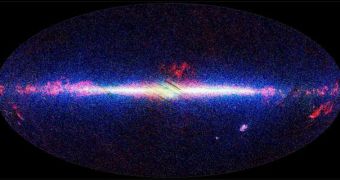All-sky surveys represent one of the most important tools in astronomy today. They allow experts to set reference points for their studies, and also to compare various celestial objects between themselves, and with newly discovered ones. For the first time in more than a quarter of a century, a new series of infrared all-sky surveys, covering in excess of 1.3 million light sources, has been made available, under the name of the AKARI All-Sky Catalogs. The information is available here and here, ScienceDaily reports.
“The release of the catalogs is very timely. Many of the objects detected by AKARI and contained in these catalogs will be prime candidates for future investigation at far-infrared and submillimeter wavelengths with Herschel. These catalogs will be very useful for astronomers preparing for the next opportunity, in May, to propose observations with Herschel,” the AKARI project scientist for the European Space Agency (EAS), Alberto Salama, explains. He shares that the new datasets could be used to derive more information on subjects such as the traits of nearby stars, on how planetary systems form around new stars, or on how stars started forming very early in the history of the Universe.
Launched in February 2006, the AKARI spacecraft was Japan's first infrared astronomical satellite. Its mission ran between May 2006 and August 2007, during which time it did a full sweep of the visible sky, imaging all the targets that eventually ended up forming the catalogs. Its two main instruments were the Infrared Camera (IRC), which worked in the 9- and 18-micrometer bands, and the Far-Infrared Surveyor (FIS), which looked at the sky in the 65-, 90-, 140-, and 160-micrometer bands. IRC holds the record for most infrared sources discovered, at 70,000 objects, with FIS trailing some distance away, with only about 430,000 objects identified.
Each of the two catalogs features data from one of these two instruments. As such, rather than producing a single, large dataset, experts decided to split the information into the AKARI-IRC Point Source Catalog and the AKARI-FIS Bright Source Catalog. Behind this ambitious project was the Japanese Aerospace Exploration Agency (JAXA), which managed the AKARI mission in collaboration with ESA. Scientists from the Seoul National University, in South Korea, have also contributed to developing the satellite and its instruments. Survey-data processing took place at the ESA European Space Astronomy Center (ESAC) near Madrid, Spain.

 14 DAY TRIAL //
14 DAY TRIAL //